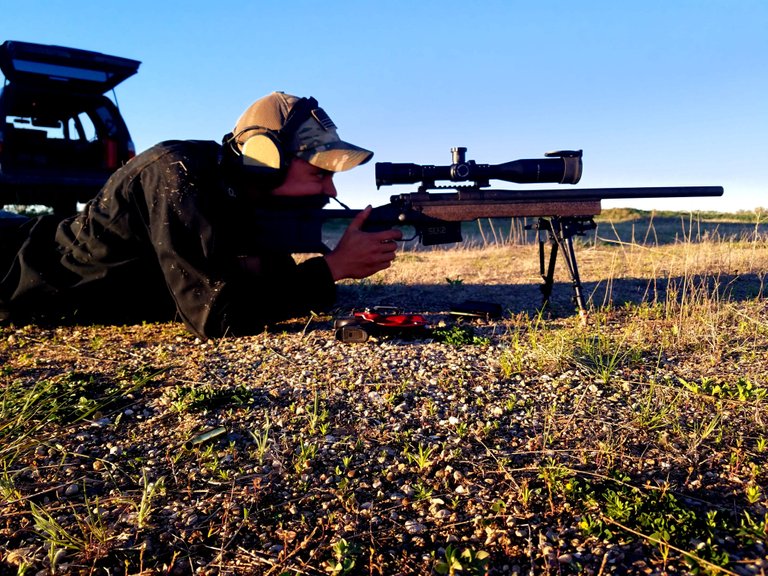
Long range precision rifle shooting is an art and a science. For decades the techniques and ideas surrounding the long range world has been shrouded in mystery, thanks in-part to its most notable practitioner, the Sniper. In the past few years, there has been a surge of popularity in long range precision rifle shooting which has led to a growing interest in the gun world. Its biggest limiting factor has been knowledge and its runner up, cost. Here we are going to focus on the basic considerations for getting into the art of long range shooting.
I suggest long range precision rifle shooting to both experienced shooters and new ones. Its a rewarding practice that feeds you consistent and actionable feedback, which you can use to make yourself a better shooter in every discipline. I use the term 'long range' to mean any type of shooting out past the usual engagement distances. Some people can get rigid with this term and say, long range shooting is only past 600 yds. There's lots of good reasons for this definition however, I disagree. Within the employment of small arms fire (less than .50cal) most shooting takes place inside 300 yards. Therefore I consider anything past that to be long range shooting. Theres also Extreme Long Range (ELR) shooting. ELR shooting is usually done at distances in access of 1000 yds. More rigidly, it is shooting at targets outside the supersonic zone of the round they are using. Which is on average past 1000 yds.
This is primarily a buying guide for the new shooter, but I will use it to explain the considerations and concepts behind the methodology. I will be focusing on the features and ideas I think play the most important roll in finding and using a precision rifle. This is the first in a series for those interested in long range shooting and if you have any questions feel free to let me know. More than likely, I will be releasing a more in depth analysis of your question in the coming articles.
So you are interested in precision rifles, or just want to shoot further than you have in the past. First you'll need a gun, usually a bolt action gun. Semi automatic rifles can be extremely accurate and reliable but in the interest of cost to effectiveness, a bolt action is the perfect entry gun. But which one? There seems to be thousands of different configurations from hundreds of different companies, how in the world will you choose between them? To start, you need to choose a cartridge. Cartridge selection should be based on; the round, WEZ, size of game, availability, and cost.
Rounds
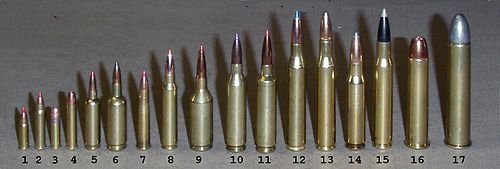
The round you choose (bullet) is separate from the cartridges or casing. How that round performs once it has left the gun and is flying in the air is called external ballistics. External ballistics is measured by its ballistic coefficient (BC) or, how well the round flies through the air. There's a lot more to how a BC is formulated and used but essentially: the higher the BC and faster it travels, the more accurate the round. Usually a manufacturer will display the BC for that round on the packaging. The typical .243 has a higher BC than the typical .308. Its smaller, faster and most importantly is less affected by wind. But, that doesn’t mean it's the best, and the bullets with the highest BC may not be the most effective choice for your use.
--WEZ
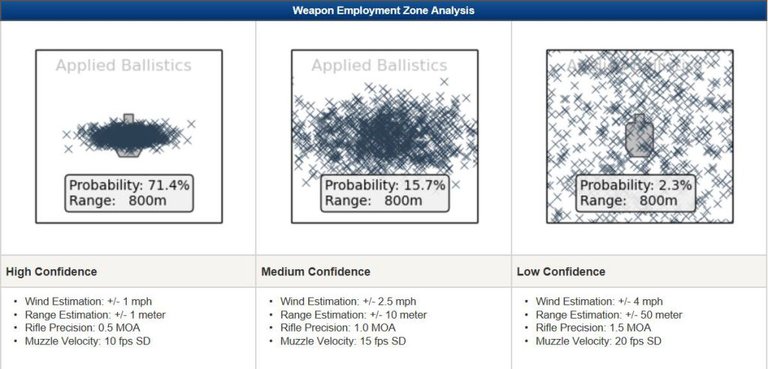
The Weapon Employment Zone is a systematic and comparative evaluation of small arms performance developed by Bryan Litz. It is different from the Maximum Effective Range calculation because it quantifies hit percentage of a given shooting system (shooter, firearm, ammunition) on a specific target. The WEZ is the range at which a shooting system can used. Different shooter systems have different WEZ. You as a shooter have more to do with the WEZ of your rifle fire than the rifle itself. The ability to read and account for wind, range and velocity will determine the hit probability to a greater degree than the rifle itself. The short of it is, you can buy the most accurate long range rifle in the world with the best scope, however your hit probability will be based on the shooters abilities confidence and ammunition. This is no trivial aspect. A .22 cal rifle in the right hands can put rounds on target in the right conditions far beyond what most shooters practice at. I'm talking 600yds+. All in all, this means GO SHOOT, track data, and incorporate feedback.
--Size of Game
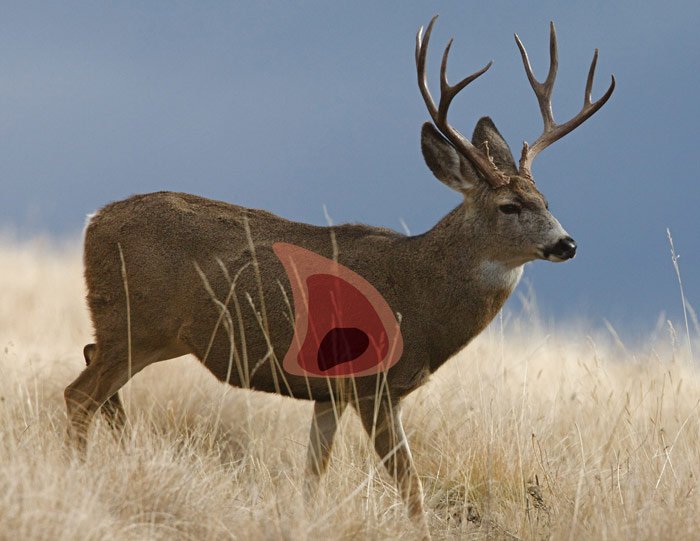
What are you going to shoot the rifle at? This means you must consider the size of your target and what its made of. If you are looking to hunt, you will need to look at how the round you select performs once it hits the target. If you are mostly shooting inanimate targets at distance like me, a hit is a hit. Paper and steel don't care what the round is.
Large game is typically over 300 pounds. This is a very loose number and the terms for game size are muddy as hell. Big game can hurt you, medium game cant, small game is small. A Mule Deer is generally considered the dividing line for medium to large game. Smaller than a mule deer is medium and bigger than a mule deer is large. When taking down large game, shot placement makes a huge difference. A critical hit with a .243 can take down a mule deer, no question about it. Generally the larger diameter of the bullet will give you a larger hydrostatic shock which gives you a larger area of effectiveness.
--Availability
What is available in your area? If your ammunition is not readily accessible, are you able to stockpile? Take a look around at what your local stores have in stock, ask them which rifle cartridge is the most available. If they have a low supply stream, it could be subject to going out of stock if a rush hits. Finally, selecting a wildcat cartridge may not be an option. Its could have the greatest ballistics ever, but if you build a shooting system around that cartridge and your supply runs out, you have a paperweight not a gun.
--Cost
This ties into availability as well. You can buy online cheaper than in the store, but having easy access to off the shelf supplies will keep you out of a jam. If you choose to stock up mainly from the store, thats fine. Lots of people do. Keeping cost in mind will keep your gun fed and keep you shooting. Everyone wants the most accurate round. Why wouldnt they? As a rule of thumb the more accurate the round, the more expensive it is. Buying a .338 Lapua or .408 CheyTac is just out of most peoples price range. Long action cartridges like 30-06 and .300 WinMag are going to be more affordable but more expensive than the short action .308 or .243. Figure out what you are willing to spend on this gun, if you were to shoot it regularly ie. more than once a month.
With your criteria I would look at something in the short action rifle category. .243, .270, .308. They are very popular and widely available rounds and are commonly used by hunters for small to medium sized game. .243 and .270 will give you better performance than the .308 when it comes to trajectory and wind deflection but there is no doubt that the .308 packs a punch. All of these calibers will be effective out to 400 yds depending on what round you choose.
The Rifle
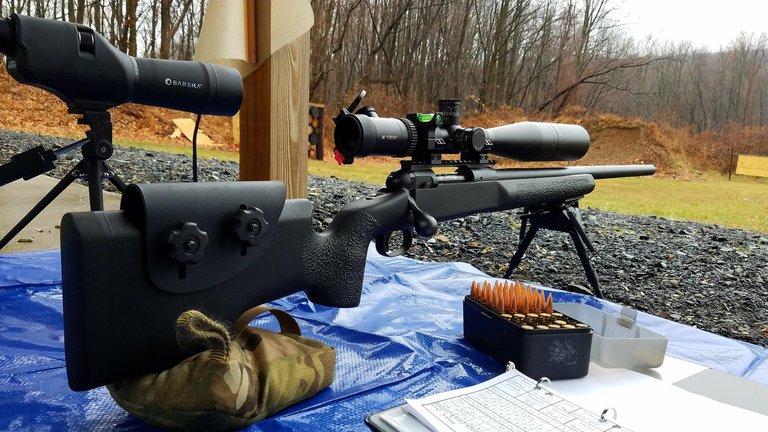
A short action rifle is cheap new and even cheaper used. If you live in a state that allows personal sales, GREAT! If you dont, most gun stores have a used section that you can look through. I have no experience buying used from a store, so I cant really help you there. As for personal sales, I wont buy unless it fits my criteria EXACTLY. Any deviation and I wont do it. Usually this means I buy it only if its in the stock configuration. New you are looking at under $700. Used prices vary and can settle somewhere around $500 depending on where you live.
My recommendations are; Savage, Tikka, and Howa rifles. They are reasonably priced, have good aftermarket support, well built and accurate.
Savage is the leader of the three in popularity. Dont be swayed by their tacticool offerings, theyre ok but not what you need when you first start out. The mass production aspect usually leaves a little to be desired on the end product. Often it takes a little elbow grease to really bring these rifles into their own. Which costs money. Either in buying the tools, or having the work done for you.
Tikka and Howa are neck in neck for me. They are well priced, within most people's range of affordability and have excellent fit and finish. Both rifles are going to exceed your abilities as a new shooter and will last a very long time. The aftermarket support for both companies is less than Savage. However your standard rifle accessories such as bipods, slings and scopes are going to all work. Aftermarket support just means, barrels, stocks, chassis, trigger systems, etc. are not as available. Both the Tikka T3X Lite and Howa Heavy Barrel Varminter go for under $700 retail. I give the edge to the Varminter because of its thicker barrel profile.
Remington. My old love... with a heavy heart I do not suggest a Remington. The quality has dropped below the competitors I have mentioned. Fit and finish is sloppy, rust is an issue, accuracy is still ok but you are more likely to get a bad Remington than a bad Savage.
--Barrels
A 20" barrel chambered for .308 with quality ammo will reach 1000 yds. Barrel length will determine the burn time of the cartridge. The longer the burn time, the more gas expands behind the round which increases the muzzle velocity. For long range shooting I recommend barrels longer than 18". You can certainly go longer but 22" is about the maximum a factory provides. Remember that you also have to use this thing, and 24" is great, but a bit unwieldy for some shooters. There is also barrel profile to consider. The profile is what gives the barrel its rigidity. Generally, the thicker profile the barrel, the more consistent the rifle will remain without letting it cool down. Thinner profiles are more commonplace and are still extremely accurate but, firing long strings (10+rounds) the barrel will heat up and lose rigidity which affects accuracy. A common hunter profile barrel will serve most people's needs just fine, but understand that as you progress in your abilities and shoot more rounds in a single sitting, your profile could end up limiting your performance.
Some barrels are threaded at the muzzle to accept suppressors or muzzle breaks. Muzzle breaks are an effective way to reduce felt recoil and keep the barrel flat for faster follow up shots. It may be a worthy investment for you if you end up devoting yourself to the sport, to add a muzzle break to your rifle. Threaded muzzles are more expensive from the factory and a typical break can be $100. They are not a necessary feature to having an accurate rifle and if they do not match properly, a muzzle device can actually negatively impact your accuracy. My suggestion, dont worry about it.
Accessories
A quality bipod. Its pricey but a quality Harris will serve you well, and your kids well, and their kids well. I suggest the HBL 9-13” model. Its not the fastest adjusting model but it allows fine tune leveling without stepping up into the more expensive swivel models. $75 retail
Scope
This is another discussion entirely.
The down and dirty is, make sure the turret adjustments match the reticle ie. MOA-MOA or MIL-MIL. Dont get wrapped up in MIL vs MOA. If you think in inches and yards- Go with MOA, if you think in centimeters and meters-Go with MIL. MOA and MILS are simply angular units of measurement used to make adjustments to the point of aim in the scope.
Choose exposed turrets over capped turrets. You want the ability to make quick fine tune adjustments without having to worry about keeping track of caps. Taking them off, making an adjustment and putting them back on is a pain in the ass.
--Fixed power vs variable power
Starting out, you dont need variable power. A 10x fixed power scope can provide accurate, reliable, and consistent hits at 1000 yds. Fixed power scopes are more reliable and sturdy than variable power scopes. There's less moving parts, which means its more rigid and less failure points. A cheap fixed power will usually be more accurate than a cheap variable power. The moving parts in a variable power scope can introduce unwanted movement and inconsistencies into your point of aim, a fixed power scope, if sturdy, will provide more repeatable accuracy. Variable power scopes are more expensive but allow a wider field of view. This means you can zoom out and track a target, then zoom back in. Thats really the only benefit to having a variable power scope.
--Tube diameter
The 'tube' is the main section of the scope where the erector assembly (turrets) are housed. Go with a quality 30mm tube. Anything smaller limits the ability to collect light and clarity. Smaller 1" tubes are common and will be fine with most applications but are generally considered to be sub-par when it comes to light collection and clarity.
--Rings
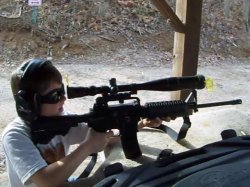
Go low, the lowest that will fit. Otherwise you will have to compromise your cheek weld or introduce risers, which add to cost.
--Scope protection
Get some scope caps and use them. They're like $10. Whenever your eyes are not looking through the glass, close up your scope.
--Reticle
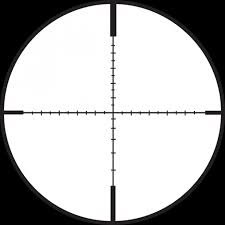
DO NOT BUY A BALLISTIC DROP COMPENSATING RETICLE (BDC redicle). You will be using the measurements of the reticle to determine the distance between your point of aim (POA) and the point of impact (POI). This will be dependent on your specific rifle and ammo. Anything that deviates from the rifle system the BDC was developed for will introduce inconsistencies, where as a more standard reticle will provide you more consistent measurements between your POA and POI. Go with a clean reticle, with simple dots or lines. I recommend that you avoid paying extra for crazy lines and measuring tools. Again, make sure the reticle matches your turrets.

My recommendation is the SWFA SS 10x42 $300 retail.
Toe support
A sand sock goes between the butt of the rifle and the ground. Its held by the non-firing hand and is manipulated to raise and lower the POA. Cheapest way is to use an old sock filled with sand ie. Sand sock. This will eliminate inconsistencies in the shooters movement and allow you to hold on target longer without fatigue.
Sling
Not that important in my opinion. Unless you're carrying other crap with your rifle such as a second or third rifle, a full sized pizza, a small child, a man-child, etc. a sling isn’t that necessary.
Practice
When I shoot for groups at 100, I shoot 3 strings of 5 rounds. The average group size is what I use to determine my accuracy. 3 shots is the minimum necessary to determine shot dispersion however, it lacks important data. If I shoot multiple 3 shot groups and the smallest of them is .8 inches wide, I do not have a sub-minute gun, nor am I a sub-minute shooter. The true representation of my shooting ability is determined by repeatable accuracy (consistency). A 5 shot group may be bigger than my 3 shot group but it tells me more about how I am performing as a shooter. If the string is diagonal (/) then I can make adjustments to my shooting position and trigger control one at a time to bring them closer (l). Then I can work on breathing control to tighten the vertical dispersion. A three shot group can erratically change its shape simply because of natural dispersion, whereas a 5 shot group tells me more about the repeated effects I am having on the gun.
Thanks for reading, GET OUT AND SHOOT
-Kev
Hi, as a sign of my support for the tag #sports and #football, I vote for you and begin to follow you
Great little write-up. I like that you used the .243 Win in several examples. I think that nowadays, sometimes we forget the tried-and-true cartridges, because the limelight isn't shining on them anymore. It's not new or fancy, but the .243 is still super capable... especially with heavier projos.
Congratulations @sek137! You received a personal award!
Click here to view your Board of Honor
Congratulations @sek137! You received a personal award!
You can view your badges on your Steem Board and compare to others on the Steem Ranking
Vote for @Steemitboard as a witness to get one more award and increased upvotes!